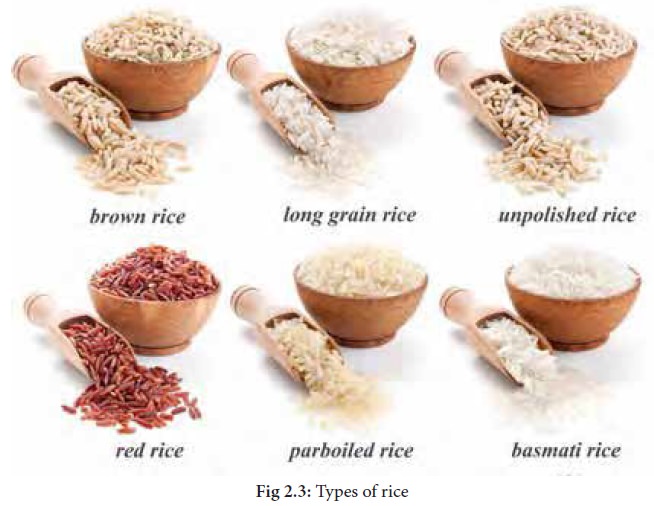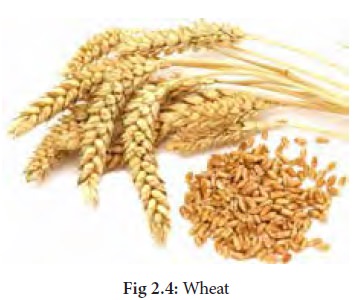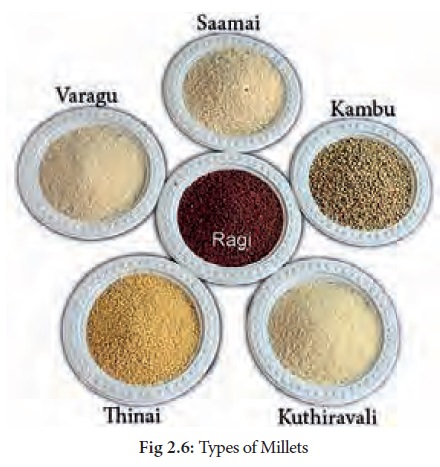Nutrition and Dietetics - Specific cereals and millets | 11th Nutrition and Dietetics : Chapter 2 : Cereals and Pulses
Chapter: 11th Nutrition and Dietetics : Chapter 2 : Cereals and Pulses
Specific cereals and millets
Specific
cereals and millets
Common cereals and millets
are
1. Rice
The
major carbohydrate of
rice is starch which is 72-75 percent. Protein content of rice is 7 percent.

Types of rice
The different types of
rice are:

Long-Grain Rice: These grains of rice
are about 4-5 times longer than they are wide, and don’t tend to clump together
when cooked.
Medium-Grain Rice: About 2-3 times longer
than their width, these types of rice can be chewy and tender, and often clump
together.
Short-Grain Rice: Often mistaken for medium-grain
rice, this variety is slightly longer than it is wide, and clumps together
easily.
Parboiled Rice: This is a type of rice
prepared in a unique way; rather than removing the outer hull to cook brown
rice, the outer shell is left on while this rice is steamed and dried. Then the
outer shell is taken off for a less clumpy and more nutrient-dense variety of
rice.
Polished rice: Polished rice is rice
that has been milled, which effectively strips away much of the protein and
vitamin content. Traditional white rice is considered a polished rice, and
therefore less nutrient-dense than other varieties.
Brown rice: Brown rice is rice in
which the inner husk is not removed meaning that it hasn’t been milled and thus
provides a much higher content of fiber and nutrients. It is unpolished whole
grain which contains 100 percent bran, germ and endosperm constituents. Brown
rice is nutritionally superior to hand pounded rice, under milled and polished
rice because it has higher amounts of protein, dietary fibre, vitamins and
minerals.
Black rice: It has a very high
concentration of anthocyanins, which gives it the black color. It is high in
nutrients and relatively rare, this rice variety is slowly becoming popular in
our Indian cuisine.
Basmati rice: Traditionally grown,
found and used in India, for making biriyanis and pulaos, Basmati rice is a
long-grain variety with a very delicate texture.
Sticky Rice: This is a rice variety
primarily grown in Asia, also known as glutinous rice.
Red rice: Red rice is similar to
black rice in that it is colored due to its unique anthocyanin content. This
provides the red color to the husk, which can either be partially or fully
removed before preparing this type of rice
Different rice products
Rice flour: Rice starch granules are
quite small and are embedded in a protein matrix. It is used in puddings, ice
creams and custard powder.
Rice bran: Bran includes several
sublayers within the pericarp and the aleurone layer. Bran is a good source of
antioxidants. Oil is taken from rice bran.
Broken rice: It is mainly used in
making upma.
Parched rice products:
This includes parched
rice, puffed rice and flaked rice. They are easily digestible and hence good
for children and old people. It adds variety in the diet. Rice flakes are a
good source of iron.
2. Wheat
Wheat grains are ovoid
in shape rounded in both ends. Wheat proteins are rich in glutamic acid and low
in tryptophan. Whole wheat is a good source of thiamin, riboflavin, niacin,
folic acid, calcium, phosphorus, zinc, copper and iron. Wheat is also a good
source of fibre. Wheat is consumed mostly in the form of flour obtained by
milling the grain while a small quantity is converted into breakfast foods such
as wheat flakes and puffed wheat.
Wheat is milled to
produce flour which is used to make a variety of products including bread
across the world. Wheat contains a protein called gluten which is necessary for
the basic structure in forming the dough system for bread, rolls and other

baked goods. Many of
the foods we consume on a daily basis such as bread, cookies, cakes, pies,
pastries, cereals, crackers, pasta, flour tortillas and noodles are all made
from wheat flour.
Products of wheat
Whole wheat flour: It contains the finely ground bran, germ and endosperm of the whole kernel. It is used in making chapathis, puris, whole wheat bread, etc.
Wheat bran: Wheat Bran is a
concentrated source of insoluble fibre and provides health benefits.
Wheat germ: It is a great source
of vegetable protein, along with fiber and healthy fats. It is also a good
source of vitamin E, magnesium, thiamine, folate, potassium and phosphorus.
Wheat rava: Broken wheat or wheat
rava is used in the making of upma, bisi bela bath, pongal, etc.
Wheat flakes: They are used as
breakfast cereals. They are packed with dietary fibre and most varieties are
fortified with numerous essential vitamins and minerals.
Maida: It is also known as
refined flour. The bran and germ are separated in making white flour or maida.
Maida bakes uniformly into a loaf of greater volume and it is more bland in
taste and more easily digested. The more the refinement, the lesser the
nutritional quality.
Semolina: It is coarsely ground
endosperm and its chemical composition is similar to that of white flour.
Macaroni products: These products are
also called pasta. These products include macaroni, spaghetti, vermicelli and
noodles

3. Oats
Oats are whole grains.
Neither the bran nor germ is removed in different forms of oats and hence all
forms like oat meal, oat flakes and oat bran are nutritious. In oats there are
significant amounts of beta glucans, soluble fibre which reduces serum
cholesterol.
4. Barley
Barley malt is used in
bakery, processed foods and in vinegar and syrup making.
5. Millets
The major millet crops
of India are:
Pearl Millet / Bajra
/Kambu: India
is the largest producer of Pearl millet. This millet is an excellent source of
phosphorus which is essential for the structure of body cells. It has the same
quantity of protein as wheat.
Finger Millet /
Nachani / Kezhvaragu: It is also known as finger millet, ragi and red millet. It is
well known in Southern India. This millet is rich in protein. The major
proteins of ragi are prolamins and glutelins and they appear to be adequate in
all essential amino acids. Ragi is rich in minerals especially calcium with
good source of iron. The malted ragi flour can be used along with germinated
green gram flour to formulate a high calorie-dense weaning food having
excellent nutritional qualities. Ragi flour can be used with milk beverages.
Foxtail Millet /Kangni
/ Thinai: Foxtail
millets are rich in iron and pest-free. Foxtail acts as anti pest

Kodo millet/Kodra/Varagu:
Kodo millet contains
high amount of polyphenols which acts as an antioxidants. It is rich in fiber
and low on fat.
Little Millet / Kutki
/ Saamai: The
seeds are smaller in comparison to other millet such as foxtail millet. Little
millet has high amount of iron content and fiber like Kodo.
Barnyard Millet /
Jhangora / Kuthiravali: Barnyard millets are good source of fiber, phosphorous as well
as calcium.
Sorghum /Jowar
/Cholam: Sorghum
is mostly cultivated due to its high fodder value. Sorghum is rich in nutrients
with high amount of protein, unsaturated fats, fiber and minerals such as
phosphorus, calcium, potassium and iron.
Health benefits of millets
The various health
benefits of millets are:
Healthy heart: Millets are rich in
magnesium which helps to lower the blood pressure and also decreases the
chances of strokes, heart attacks and antherosclerosis.
Balance cholesterol
level: The
high amount of fiber found in Millet helps to lower the cholesterol.
Prevent diabetes: It helps to reduce the
risk of Type 2 diabetes as it possesses an adequate amount of magnesium.
Assist digestion: Since millets are rich
in fibre, it helps to enhance the gastrointestinal health and eradicate the
ailments such as excess gas, constipation, cramping and bloating.

Prevent cancer: Research shows that
fibre is the simplest way to prevent the outbreak of breast cancer in women.
Since millets are rich in fiber, it can prevent occurance of breast cancer.
Detoxification: Millet contains
antioxidants which help to neutralize the free radicals that can lead to cancer
and also clears up the toxins from the liver and kidney.
Respiratory health: Research shows that
Millet helps to improve the respiratory health and also prevent asthma.
Related Topics